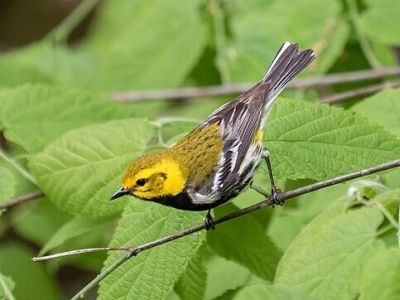B-BTNW-Black-throated Green Warbler

Black-throated Green Warbler
Setophaga virens
- Phylum: Craniata
- Class: Aves
- Order: Passeriformes
- Family: Parulidae
The black-throated green warbler (Setophaga virens) is a small songbird of the New World warbler family. It has an olive-green crown, and a yellow face with olive markings.
General Information
Key Habitat Features
Mature and old growth mixed wood forest (aspen and deciduous with some conifer component (white spruce/spruce) and good canopy closure) with lush herbaceous layer, free mid canopy space and dense low shrubby understory; key forb/herb species (baneberry, rose, highbush, cranberry, fireweed, mosses, kinnikinnick, peavine and bunchberry).
Mature mixed wood forested adjacent to riparian reserves.
Mature and old deciduous-leading forest patch sizes >2 ha.
Objectives
Minimize disturbance during the breeding season.
Maintain nesting habitat throughout all seasons.
Maintain desired plant communities and key habitat features.
Planning and Operational Measures
All Activities
Identify key habitat features using appropriate measures (i.e. QP direction, desktop review, field confirmation, etc) and plan activities within the operating area accordingly.
Retain unfragmented mature forest patches >2 ha, within identified Black-throated Green Warbler habitat.
Within identified habitat, avoid activity within riparian areas consisting of mature coniferous or mixed wood forest.
Avoid sensitive areas such as nest sites and foraging habitat.
Time works such that they occur outside of the critical timing window.
All Activities
Undertake construction and operation of oil and gas activities in a manner that minimizes impacts to desired plant communities and key habitat features.
Timing considerations when working within identified habitat:
Avoid disturbance and/or clearing activities during the critical timing window from June 1 to July 31.
Where an application area is within a NEBC WHA for Black-throated Green Warbler, please refer to the EIMS summary for that Order. Proponents are required to adhere to the guidance provided in that summary, including any relevant timing considerations.